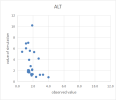Hello,
I am simulating the thickness of active layer, but I found that the thickness of active layer in some sites is much larger than the measured value. May I ask what parameters should I adjust to slow down its melting? I have been searching for parameters, but I have not found the appropriate parameters that are most likely to affect the thickness of active layer.Can you please give me some advise?

I am simulating the thickness of active layer, but I found that the thickness of active layer in some sites is much larger than the measured value. May I ask what parameters should I adjust to slow down its melting? I have been searching for parameters, but I have not found the appropriate parameters that are most likely to affect the thickness of active layer.Can you please give me some advise?

